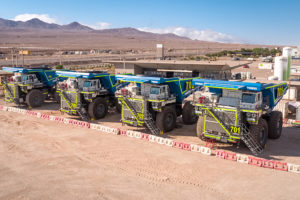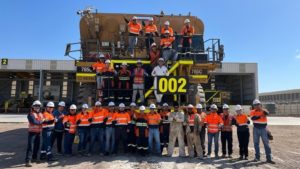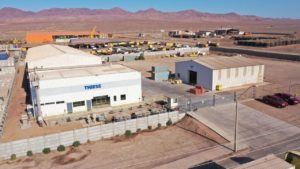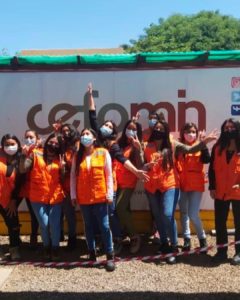Outside of its most established markets of Australia and Indonesia, Chile is a key focus region for the world’s top mining contractor, Thiess. On a recent visit to Chile, IM Editorial Director Paul Moore met with Darrell White, Thiess Group Executive, Americas, at its corporate office in Santiago, to talk about its journey in the country so far, the contracting market in that part of the world, potential for growth and plans for the future
Q Arguably Australia hosts the world’s most mature open pit contract mining market. How does the contracting business in Chile differ, what potential does it have and how can Thiess grow that market?
You are right that contracting in Australia is very mature and ingrained into the mining culture. Mining companies there understand the value and commercial benefits contractors can bring to them. By passing certain risks onto a mining services provider, miners are often able to significantly de-risk their operations.
Chile is a relatively new contracting market — the concept of turning your operation over to a third party is still somewhat foreign to many mine owners here. Although there is quite a robust service provider market within Chile for areas like tyre management, fleet maintenance, explosives supply and delivery — as well as drill and blast — full-service mining contracts are still a relatively new idea. We are seeing more interest from companies who want to take that full-service step and all the benefits that come with it. We will continue to demonstrate the efficiencies and commercial viability of this approach.
Another benefit we bring to the market is the ability to incorporate new technologies in our offering, and mining groups in Chile are very pro-technology. We have done a lot worldwide across our various operations – our challenge is to make those insights and innovations better known to our Chilean clients, existing and potential, so that, together, we can continue moving the industry forward. Mining in Chile is focused on learning and taking advantage of what is being done elsewhere. There are clearly some cultural and knowledge differences between Chile and Australia, as an example, in addition to the mines themselves being quite different in setting and layout. There are adjustments that need to be made – but through various METS-related investment programs, and the support of others, Chile is increasingly becoming a leader in tech-focused mining, while several Chilean universities are also playing leading roles in mining R&D and innovation. Thiess will play our part in helping move things forward based on our experience and know-how.
Q Is your focus in Chile currently mainly load and haul or also drill and blast and other opportunities?
We can and will provide services based on the scope open to us by the client. Our ideal scenario is to offer full service. For us, that means everything from planning and engineering the blast patterns and haulage approach at the mine to performing all of this work, in addition to areas like explosives delivery and rehabilitation. Short- and long-term mine planning is a core part of our business, and the haulage itself is just a part of that — maintenance and how we manage our assets is just as important. At the same time, we are agile, and we work with our clients in the way they want us to work, while simultaneously emphasising our full capability. In this part of the world, load and haul is most often part of the scope, along with drilling and operational maintenance, while mine owners outsource the actual explosives loading and blasting elsewhere. In Chile, Orica and Enaex are both present for this work on pretty much all of the mine sites, as that is their area of expertise. On the mine planning side, the decision will often come down to owner preference and the mine type.
Q Can you give a brief timeline of Thiess’ involvement in the Chilean market? How did you establish your major facilities and get the equipment that you needed in country?
We entered the Chilean market in 2015, initially through the award of a client contract at Minera Centinela’s Encuentro Oxides project. We initially took on some equipment that was already in country, and we later took over that contract as the sole service provider when it was renewed in 2018. We brought in new equipment to Chile from abroad on two other occasions to enable us to expand our fleet offering here, including units from Mongolia in 2017.
Most recently, in 2022, we brought in five new electric-wheel-drive Liebherr T 264 trucks. We have continued to enhance our asset presence in Chile over time. This is to continue fulfilling our contractual commitments already in place with Centinela, but also to ensure we have the fleet on hand as opportunities at other operations emerge. The mining services business is opportunistic — sometimes you can see the opportunities coming down the line ahead of time, but in other cases, new possibilities come up if you have the fleet.
Liebherr electric drive T 264 trucks form an important part of Thiess’s fleet in Chile

Now is a good time to be in mining services in Chile because the mining companies have slowed down their capital investment for various reasons, including the aftermath of the pandemic in addition to political changes and other risks. But they still want to maximise production while the price of copper is high. In this scenario, we can come in, take on some of that work and help them reach their strategic goals, while reducing their risk. Once we start work, we can demonstrate what we do and how efficient we are, hopefully leading to longer-term relationships.
Q Your long-term mining services customer in Chile is AMSA owned Minera Centinela – can you detail how you have been involved there since 2015?
The Centinela mining district has multiple different pits that are broadly divided between sulphide and oxide copper operations. First, there was the Tesoro Central oxide pit that started in 2001. The Esperanza sulphide pit began in 2011 and later merged to form the Centinela district. We carried out some initial work at Esperanza and then when the Encuentro Oxides project came along in 2017, we opened that pit and worked there for many years. Following that, the Esperanza Sur pit began operations close to Esperanza with an autonomous fleet. The Mirador and Tesoro Sur pits in the oxides came next. After that, we moved from Encuentro Oxides in late 2022 to the new Llano pit, also in the oxides area, located between Esperanza Sur and Tesoro Central.
Thiess’s focus at Centinela has now moved to the new Llano pit

Today Centinela still has huge resources and potential to further develop. Most of our fleet has remained in the Centinela District and moved within it as needed. When we have had any excess fleet, we have utilised our capability to deploy it elsewhere. For example, a few years ago, we did some work for the Mantos Blancos operation of Capstone Copper. We also have Cat 793 trucks working at BHP’s Escondida today in a dry hire application. We are capable of carrying out full truck rebuilds at our maintenance workshop (ITTEC) in La Negra, near Antofagasta, which is great location to house trucks that are ready for new opportunities.
Q Can you go into more detail on the La Negra facility – its capabilities and potential?
Our Innovation, Training and Technology Center (ITTEC) is primarily a rebuild centre for Thiess. It has the capacity to also carry out similar work for other clients in the future. We have the space and capability to do third-party maintenance and rebuilds. ITTEC is also where we train our maintenance and operations people, and we run our maintenance apprenticeship program there.
The Thiess Chile ITTEC in La Negra, near Antofagasta

Eventually, ITTEC will house a remote operations centre, including a dispatch room that controls our assets across multiple different operations. It will host operators and monitors for remote control drills or dozers. In terms of fleet management, if we have a full fleet at a customer mine site, we will have our own FMS and upload data into the client system. However, if the client has their own FMS that they want us to use, we will do so and operate it for our fleet. Lastly, there is also a lot of potential for us to deploy autonomous haulage in Chile, and we could manage that from our remote centre. We have already commenced operations at our first mostly autonomous mine in Australia, so we will look to bring this capability to Chile. This operation is also the first contractor-led mine with autonomous drilling and hauling.
Until now, clients have tended to keep AHS in house. This shift demonstrates that we have a role to play, and with the right commercial agreement, we can deploy autonomous solutions so that the client can focus on downstream commodity production and sales. Overall, a remote operations centre for a large mining services provider would be another world first.
Q Can you talk a bit more about ITTEC and your commitment to diversity and training in Chile?
A big part of our growth business model and strategy is to increase the number of women in our workforce by 20% year-on-year. We have strong gender diversity across our staff and office-based roles, but we want to see more women represented in operations. While we do have some women operators and maintainers, it’s important that we encourage more women to join our teams and actively foster a culture of inclusiveness. In the most recent cohort of our maintenance apprenticeship at ITTEC, half of the apprentices were women, mostly from the Antofagasta area.
In collaboration with registered training partner Cefomin, Thiess’ team in Chile in 2021 launched an inaugural scholarship programme for women interested in a potential career in mining

Once we get the remote operations centre running in La Negra, we also plan to provide opportunities within our organisation to people with disabilities who have traditionally been unable to work in mining operations. In this capacity, we can also utilise the skills of older people who still want to work. It’s important to us that we also prioritise suppliers that are more diverse in terms of their owners, workers and management.
Q On the Liebherr T 264 – why did you opt to deploy that model specifically and what attributes does it have that have been useful in the Chilean market? Plus, what shovels do you operate in Chile?
Strategically, we are always looking across the globe for the best investments where we can make the greatest positive impact. In Chile, we have brought a lot of fleet into the country from other operations. As we hadn’t purchased any new machines in country before the T 264s, we wanted to make a capital investment into new machines for our Chilean business. It was also the right timing. Liebherr had recently released the T 264 and had machines available.
As a group, we also deployed the T 264 at our first US-based client’s operation in Colorado. The prevalence of electric-wheel-drive trucks in Chile also contributed to our decision, as we wanted to offer the latest technology in drive haulage electrification. Plus, there’s a lot of knowledge in Chile around how to best operate and maintain these trucks. In terms of the T 264 itself, when they are running well, they have a bigger payload capacity than other trucks in this class, and they are faster, so you can maximise the benefits for a more productive mine. In terms of shovels, wehave three Liebherr backhoe hydraulic shovels and two Caterpillar 6060 face shovels, as well as a PC5500 Komatsu machine. This type of shovel and class is similar to what we have elsewhere in the world.
Q You are part of the HYDRA Consortium, developing a fuel cell electric mining truck for mining in Chile – how and why did Liebherr get involved in that?
We have been looking at various types of zero emissions technologies in haulage, including hydrogen, so it made a lot of sense for us to be involved. Our OEM partner on the T 264, Liebherr, is also a partner in HYDRA, as an example, as is Antofagasta Minerals, our largest Chilean client via Minera Centinela, which saw the first stationary testing of the HYDRA powertrain. Chilean state agencies are also very involved.
Of course, we are looking at other options, like all battery electric, but we must learn as much as we can. In the end, it is unlikely that just one technology will provide the answer for every site, so we need to explore the different options. We have one of the largest mining equipment fleets in the world, meaning we have a vested interest in getting our own emissions roadmap right, while helping our clients meet their net zero commitments. We take on the responsibility to do some of those tasks for them. More chances to deploy new technologies help us gain valuable experience and enable us to gather important data.
Different technologies may suit different customers better and different regions better, depending on energy infrastructure. Some tech will become available or commercial sooner than others. And there are interim steps too – bridge technologies like dual fuel that will allow us to reduce emissions in the near term. For example, we are working with MES in Australia to test the viability of dual fuel options.
We have committed to a 25% reduction in diesel consumption in our Thiess-operated fleet by end of 2025, as compared to 2019 levels. It is important to note that as a services provider, our fleet emissions are effectively Scope 3 for us, but they are Scope 1 for our clients, as determined by our respective roles in the operations. As a company, we have also committed to net zero Scope 1 and 2 emissions at our facilities like offices and rebuild centres by end of 2025.
Q Trolley assist is also making a comeback – for diesel trolley but also leading into battery trolley. Where does Thiess stand on that given the high initial cost and lower flexibility?
We have electric-wheel-drive trucks and would welcome the opportunity to use trolley. We think it’s a great technology. The challenge, and at the same time opportunity, is finding the right mine with the right layout and plan then working with the client to execute. It would involve a close partnership with the client, similar to what we have today, for the full service work we do. In the case of trolley, there would be a longer time commitment. There may be a need for wider haul roads, as well as the need to know what the payback is, and how often you will need to move the trolley line or lines, if ever. In-pit crushing and conveying will also have a role to play in the right situations, allowing displacement of trucks in some cases. It is also capex-heavy and will only be suitable for mines running on 100% renewable energy.
Q Peru is next door and also has a large mining industry with a lot of world class open pit operations – is that a focus for the future?
Peru is a focus area that we have been watching for a long time. As with Chile, our entry into Peru will most likely be with a particular client that sees the value that we bring. One possibility is a client we have worked with elsewhere asking us to apply our expertise in Peru. Similar to Chile, Peruvian miners are familiar with the early works part of contracting in mining, such as initial infrastructure development and earthworks, but less acquainted with the full-service model. Peru also has a plethora of junior and mid-tier miners with sizeable mines in planning or in early production, but that lack the necessary fleet investment or trained staff to optimise or increase production. These entities are also logical partners for us. Early on, they will likely be focused on cashflow and want our services to move tonnes. Later, they may also want more advanced technologies, just like the majors. On the bigger picture with Peru, we obviously have our own internal controls, and we will do the necessary due diligence for any opportunities that arise, including risk assessment. At the right time and with the right approvals, we can make a strategic entry – but again, it will be with a client. We are looking today at when that might be.
Q Thiess Rehabilitation was set up as a standalone entity in 2022 – what is the potential for growth in this business in Chile?
We have over 20 years of mine rehab experience, primarily in Australia and Indonesia, which each have their own challenging climatic conditions and are often subject to high rainfall at certain times of the year. Some of the mines where we work are also close to urban areas, so we are carrying out land rehabilitation. A lot of this work involves landform shaping and waste material movement with dozing work as we mine. In Chile, most of the mines are quite remote and in very dry climates, so the requirements are different, but that doesn’t mean they don’t need rehabilitating. We are currently having discussions about how we can bring our capability with this type of work to bear, especially for some of the big mine closures that will soon occur in Chile. This could include contouring or profiling that could be done with remote or autonomous dozing, with which we already have considerable experience. For permitting of future mining projects in Chile, rehabilitation will become more integral to the environmental impact study and life-of-mine plans, including ongoing rehab work during operations, not just at closure. Chile has already led the way in regulations relating to mining and things like water usage and tyre recycling – mine rehab will just be another aspect of this.